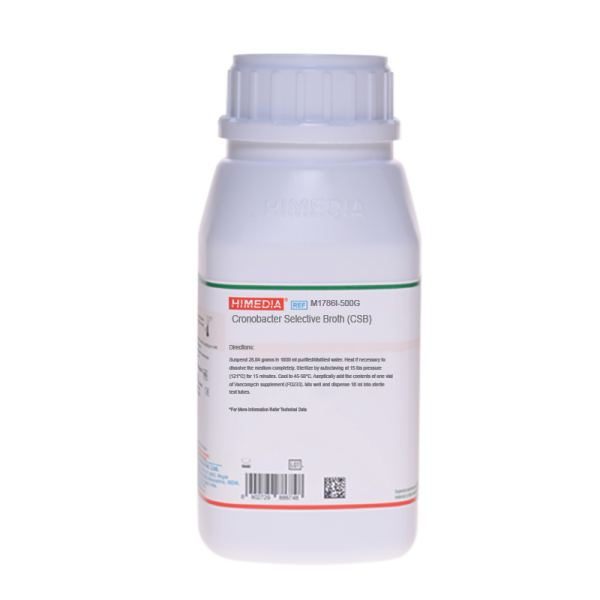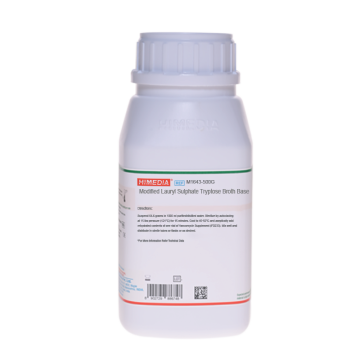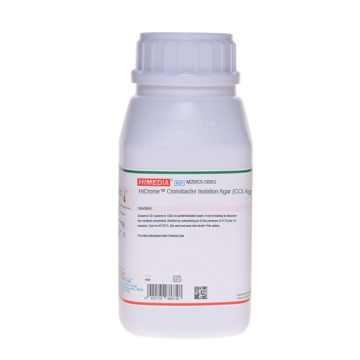 Your enquiry has been submitted
Your enquiry has been submitted
Cronobacter Selective Broth (CSB)
Intended Use
Recommended for screening Cronobacter (formerly Enterobacter sakazakii) from food. The composition and performance of this media are as per specifications laid down in ISO 22964:2017(E).
Composition**
| Ingredients | g / L |
|---|---|
| Peptone | 10.000 |
| HM Extract # | 3.000 |
| Sodium chloride | 5.000 |
| Bromocresol purple | 0.040 |
| Sucrose | 10.000 |
Final pH (at 25°C): 7.4±0.2
FD233 Van10 Selective Supplement
| Ingredients | Concentration |
|---|---|
| Vancomycin | 10mg |
**Formula adjusted, standardized to suit performance parameters
# Equivalent to Meat extract
Directions
Suspend 28.04 grams in 1000 ml purified / distilled water. Heat if necessary to dissolve the medium completely. Sterilize by autoclaving at 15 lbs pressure (121°C) for 15 minutes. Cool to 45-50°C. Aseptically add the contents of 1 vial of Van10 Selective Supplement (FD233). Mix well and dispense 10ml into sterile test tubes.
Principle And Interpretation
Cronobacter (formerly Enterobacter sakazakii) are gram-negative rod-shaped Enterobacteriaceae that have been implicated in outbreaks of disease causing sepsis, meningitis and necrotising enterocolitis (1). Cronobacter species have also been isolated from powdered infant formula as high tolerance to desiccation provides a competitive advantage in dry environments increasing the risk of contamination (2).
Cronobacter Screening Broth was specifically designed by Iversen et al. (3). Cronobacter Selective Broth is recommended by ISO Committee for the isolation of Cronobacter species from food samples (4). Peptone and HM extract provide carbonaceous, nitrogenous and growth nutrients. Sodium chloride maintains osmotic equilibrium. Sucrose is the fermentable carbohydrate and bromocresol purple is the indicator. Sucrose is fermented by Cronobacter. Consequently the broth turns yellow after incubation.
Type of specimen
Food samples
Specimen Collection and Handling
Test portion: To prepare primary dilution, add 10g or 10ml of the test sample to 90ml of pre-enrichment medium (BPW).
Pre-enrichment: Incubate the inoculated pre-enrichment medium between 34°C and 38°C for 18h ± 2h.
Enrichment: After incubation of the inoculated pre-enrichment medium, mix well and transfer 0.1ml of the obtained culture into 10 ml of CSB and mix well. Incubate at 41.5°C for 24h ± 2h.
Isolation of presumptive Cronobacter spp.: From enrichment culture, inoculate 10 µl onto surface of CCI Agar. Incubate at 41.5°C for 24h ± 2h.
Confirmation: Biochemical tests are performed for confirmation.
Warning and Precautions
Read the label before opening the container. Wear protective gloves/protective clothing/eye protection/ face protection. Follow good microbiological lab practices while handling specimens and culture. Standard precautions as per established guidelines should be followed while handling specimens. Safety guidelines may be referred in individual safety data sheets.
Limitations
- Individual organisms differ in their growth requirement and may show variable growth patterns on the medium.
- Each lot of the medium has been tested for the organisms specified on the COA. It is recommended to users to validate the medium for any specific microorganism other than mentioned in the COA based on the user’s unique requirement.
Performance and Evaluation
Performance of the medium is expected when used as per the direction on the label within the expiry period when stored at recommended temperature.
Quality Control
Appearance: Cream to yellow homogeneous free flowing powder
Colour and Clarity of prepared medium: Purple coloured clear solution forms in tubes.
Reaction: Reaction of 2.8% w/v aqueous solution at 25°C. pH : 7.4±0.2
pH: 7.20-7.60
Cultural Response: Cultural characteristics observed with added Van10 Selective Supplement (FD233), after an incubation at 41.5 ± 1°C for 24 ±2 hours. The broth is recovered on HiCrome™ Cronobacter Isolation Agar (CCI Agar) (M2062I) and incubated at 41.5±1°C for 24±2 hours.
| Organism | Inoculum (CFU) | Growth | Colour of medium | Colour of Colony on M2062I |
|---|---|---|---|---|
| Cronobacter sakazakii ATCC 29544 (00214*) | 50-100 | good-luxuriant | yellow colour | blue-green |
| Cronobacter muytjensii ATCC 51329 (00213*) | 50-100 | good-luxuriant | yellow colour | blue-green |
| Staphylococcus aureus subsp. aureus ATCC 25923 (00034*) | 50-100 | none-poor | purple | - |
| Staphylococcus aureus subsp. aureus ATCC 6538 (00032*) | 50-100 | none-poor | purple | - |
| Mixed cultures | ||||
| Cronobacter sakazakii ATCC 29544 (00214*) + Staphylococcus aureus subsp. aureus ATCC 25923 (00034*) | 50-100 | good-Luxuriant | yellow | blue-green |
| Cronobacter sakazakii ATCC 29544 (00214*) + Staphylococcus aureus subsp. aureus ATCC 6538 (00032*) | 50-100 | good-Luxuriant | yellow | blue-green |
| Cronobacter muytjensii ATCC 51329 (00213*) + Staphylococcus aureus subsp. aureus ATCC 25923 (00034*) | 50-100 | good-Luxuriant | yellow | blue-green |
| Cronobacter muytjensii ATCC 51329 (00213*) + Staphylococcus aureus subsp. aureus ATCC 6538 (00032*) | 50-100 | good-Luxuriant | yellow | blue-green |
*Corresponding WDCM numbers.
Storage and Shelf Life
Store between 10-30°C in a tightly closed container and the prepared medium at 15-30°C. Use before expiry date on the label. On opening, product should be properly stored dry, after tightly capping the bottle in order to prevent lump formation due to the hygroscopic nature of the product. Improper storage of the product may lead to lump formation. Store in dry ventilated area protected from extremes of temperature and sources of ignition Seal the container tightly after use. Product performance is best if used within stated expiry period.
Disposal
User must ensure safe disposal by autoclaving and/or incineration of used or unusable preparations of this product. Follow established laboratory procedures in disposing of infectious materials and material that comes into contact with sample must be decontaminated and disposed of in accordance with current laboratory techniques (6,7).
Reference
- Mullane et al. 2007. Minerva Pediatr. 59.137-148.
- Lai. 2001. Medicine. 80.113-122.
- Iversen et al. 2008. Appl. Environ. Microbiol. 74, 2550-2552.
- International Organization for Standardization. Microbiology of the food chain- Horizontal method for the detection of Cronobacter spp. Draft ISO/ TS 22964, 2017 (E).
- Salfinger Y., and Tortorello M.L., 2015, Compendium of Methods for the Microbiological Examination of Foods, 5th Ed., American Public Health Association, Washington, D.C.
- Isenberg, H.D. Clinical Microbiology Procedures Handbook 2nd Edition.
- Jorgensen, J.H., Pfaller, M.A., Carroll, K.C., Funke, G., Landry, M.L., Richter, S.S and Warnock., D.W. (2015) Manual of Clinical Microbiology, 11th Edition. Vol. 1.
| Product Name | Cronobacter Selective Broth (CSB) |
|---|---|
| SKU | M1786I |
| Product Type | Regular |
| Physical Form | Powder |
| Origin | Animal |
| Packaging type | HDPE |
| References | 1. Mullane et al. 200 |
| Customized Product Available | No |








